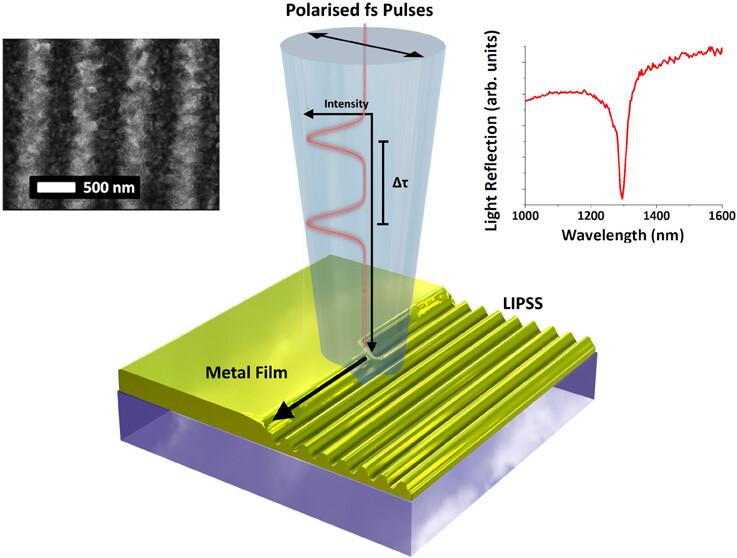
The theoretical and experimental study, titled "Double-Pulse Femtosecond Laser Fabrication of Highly Ordered Periodic Structures on Au Thin Films Enabling Low-Cost Plasmonic Applications," published in ACS Nano, showcases pioneering research carried out by scientists from the Institute of Electronic Structure and Laser (IESL) at FORTH - Fotis Fraggelakis, Panagiotis Lingos, George D. Tsibidis, and Emmanuel Stratakis - in collaboration with Emma Cusworth, Nicholas Kay, Laura Fumagalli, Vasyl G. Kravets, and Alexander N. Grigorenko from Manchester University and Andrei V. Kabashin from Aix Marseille University.
Overview and Results
The researchers proposed a novel technique involving double femtosecond pulse (~170 fs) laser-assisted structuring to fabricate periodic plasmonic arrays on thin (~32 nm) gold films deposited on glass substrates. These arrays enable the excitation of surface lattice resonances (SLRs) or quasi-resonant features, which are highly valuable for biosensing and other applications. Traditional methods for producing such structures over large areas, such as electron beam lithography, are typically expensive and time-consuming, limiting their practical use.
In their study, the team demonstrated a single-step process that produces homogeneous and highly ordered laser-induced periodic surface structures (LIPSS) over large areas. Their experimental findings highlighted the critical role of the interpulse delay between the two laser pulses, identifying it as the key parameter that determines the uniformity and order of the resulting structures.
Theoretical modeling supported the experimental observations and provided important insights into the underlying mechanism of structure formation. Furthermore, ellipsometric measurements revealed that these LIPSS exhibit strong plasmonic behavior, including ultranarrow resonances linked to diffraction-coupled SLRs—features particularly important for biosensing and other applications.
Overall, the researchers demonstrated that femtosecond double-pulse laser structuring offers a promising, low-cost approach for large-scale fabrication of highly ordered and functional plasmonic structures.
Corresponding authors from IESL: Dr. Fotis Fraggelakis - Institute of Electronic Structure and Laser (IESL), Foundation for Research and Technology (FORTH),
Dr. Emmanuel Stratakis - Institute of Electronic Structure and Laser (IESL), Foundation for Research and Technology (FORTH) & Department of Physics, University of Crete
More details: https://doi.org/10.1021/acsnano.5c06177


